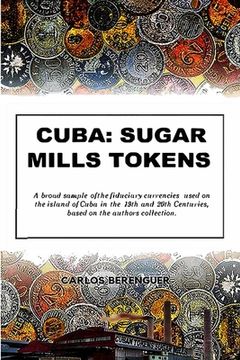Cuba: SUGAR MILLS TOKENS: (B&W) A broad sample of the fiduciary currencies used on the island of Cuba in the 19th and 20th C (en Inglés)
Reseña del libro "Cuba: SUGAR MILLS TOKENS: (B&W) A broad sample of the fiduciary currencies used on the island of Cuba in the 19th and 20th C (en Inglés)"
At the time of the Spanish rule on the Island of Cuba, then so-called "the ever faithful Island of Cuba", payments, whether they were financial transactions, consumption of goods, services or simply to honor an agreement, were made in strong currency, Spanish currency for the most part, the Real de Vellón1 or the medio Real de plata2, which honored its denomination on the basis of its specific material value, since they were mostly made of precious metals, gold, silver, etc. The cost of producing these coins was high and the amount of precious materials needed was scarce; that is why coins were made of materials of inferior value such as bronze, copper, aluminum, nickel or brass for denominations of a lower value, but even so, it was common for there to be a shortage of coins. They were not enough if we consider that the island was enjoying an economic boom at the time. Another factor was the necessary fragmentation of the coins and their values, very often those of a lesser denomination surpassed the value of articles or services that were cheaper. Consequently, in extreme cases, the coin was even physically cut in half, quarters or bits, since it was very difficult to make convenient payments for goods or services whose value did not reach that of the coin per se. These coins that had been divided into halves or bits were referred to as Macuquinas. This situation hindered financial transactions and became an obstacle for the development of the Island's economy. To illustrate this idea with an example, a gold peso coin, did it have enough intrinsic value to buy a cow? So how was it possible then to pay for a chicken? Or for a few eggs? Without the availability of enough lower denominations, it was a dilemma. Before the private coins or tokens (sometimes called pseudo-coins or chips) were made, some merchants accepted coins in circulation and because they had a greater value than that of the item purchased, storekeepers would give their change in pieces of brass, tin, or any other metal with die markings that had little or no ornamental or manufacturing rigor, and thus they gave credit for the difference between the cost of the product and the coin that had been handed over. The concept of fiduciary currency is not very far from what was known in those years as Fichas or Tokens, nor from the cryptocurrencies of today, which are nothing but high-tech Tokens. It was necessary to create equivalent coins, without any intrinsic value, made of materials that did not cover its actual value, but guaranteed an agreement, a payment, but not with precious materials but based on the trust and honesty of he who issued them. Just like the dollar today is nothing but a simple piece of paper, and its value is reflected in the trust of US economic and productive power applying the concept of inorganic or fiduciary currency, by 1600 Cromwell's government was already applying it in England with the use of Tokens. The Spanish government was no stranger to the need for fractional currency and in 1833, they began to send to the island copper coins of a lower value, 5 and 10 centimes, and they were referred to as perras chicas and perras gordas3, respectively. But not even so were they able to properly meet the need for fractional coins. Without a doubt, the Cuban sugar industry tokens are the most important items in this story, nevertheless, we present a large number of equally interesting tokens. ............

